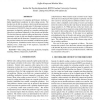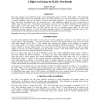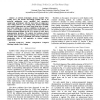ICASSP
2011
IEEE
13 years 9 months ago
2011
IEEE
Stereoscopic video is an important manner for 3-D video applications, and robust stereoscopic video transmission has posed a technical challenge for stereoscopic video coding. In ...
ICMCS
2010
IEEE
14 years 6 months ago
2010
IEEE
The ongoing increase of computing performance facilitates a higher algorithmical complexity in video coding systems. The decoder may be able to estimate or derive prediction param...
VCIP
2000
14 years 7 months ago
2000
This paper introduces some preliminary results of the standardization process of ITU-T's H.26L project. This forthcoming video coding standard will not only significantly imp...
LREC
2008
14 years 7 months ago
2008
We present a new coding mechanism, spatiotemporal coding, that allows coders to annotate points and regions in the video frame by drawing directly on the screen. Coders can not on...
APCCAS
2006
IEEE
14 years 7 months ago
2006
IEEE
As network technologies advance, Scalable Video Coding (SVC) has become increasingly popular due to its universal multimedia access capability and competitive compression performan...
ICVS
1999
Springer
14 years 10 months ago
1999
Springer
While computing power and transmission bandwidth have both been steadily increasing over the last few years, bandwidth rather than processing power remains the primary bottleneck f...
ICIP
2000
IEEE
14 years 10 months ago
2000
IEEE
Traditionally, region-based image and video coding have been addressed only in the context of low and very low bit-rate coding. However, one of the most interesting by-products of...
ICIP
2000
IEEE
14 years 10 months ago
2000
IEEE
Abstract—We describe a trellis-based algorithm which enables R-D optimum quantization decisions in the H.263+ video coding standard. The algorithm allows the quantization decisio...
DCC
2000
IEEE
14 years 10 months ago
2000
IEEE
This paper contains two contributions to very-low-bitrate video coding. First, we show that in contrast to common practice incremental techniques for rate-distortion optimization ...
PCM
2001
Springer
14 years 10 months ago
2001
Springer
This paper presents a fast and robust sprite generation algorithm for MPEG-4 video coding. Our contributions consist of two aspects. Firstly, a fast and robust Global Motion Estima...





